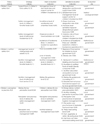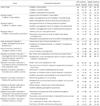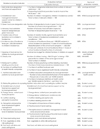Abstract
This study was performed to develop a children's dietary life safety index required by the Special Act on Safety Management of Children's Dietary Life enacted in 2009. An analytical hierarchy process was used to obtain initial weights of dietary life safety evaluation indicators. The Delphi method was applied to develop the weights along with 98 food and nutrition professionals. Three representative policy indicators, nine strategy indicators, 11 main evaluation indicators, and 20 detailed evaluation indicators were selected for the children's dietary life safety assessment. Three policy indicators and nine strategy indicators were the following: children's food safety indicator (support level of children' safety, safety management level of children's favorite foods, and safety management level of institutional food service), children's nutrition safety indicator (management level of missing meals and obesity, nutrition management level of children's favorite foods, and nutrition management level of institutional food service), and children's perception and practice level indicator ("Dietary Life Law" perception level, perception, and practice level for dietary life safety management, perception, and practice level for nutrition management). Weights of 40%, 40%, and 20% were given for the three representative policy indicators. The relative importance of nine strategic indicators, which were determined by the Delphi method is as follows: For children's food safety, support level of children's safety, safety management level of children's favorite foods, and safety management level of institutional food service were given weights of 12%, 9%, and 19%, respectively. For children's nutrition safety, the missing meals and obesity management level, nutrition management level of children's favorite foods, and the nutrition management level of institutional food service were given weights of 13%, 11%, and 16%, respectively. The "Dietary Life Law" perception level, perception and practice level of dietary life safety management, and perception and practice level of nutrition management were given weights of 4%, 7%, and 9%, respectively.
Figures and Tables
References
1. Yi SJ. A Study on the Contents and Legal Problems of the Children Food Preference Management System Under the 'Special Act on Children Eating Habit Safety Management'. Public Law J. 2009. 10(4):327–350.

2. Special Act on Children Eating Habit Safety Management. Available from: http://www.law.go.kr/.
3. School Health Index. CDC. Available from: http://www.cdc.gov/HealthyYouth/SHI/.
4. Patterson RE, Haineses PS, Popkin BM. Diet Quality Index: Ca-pturing a multidimensional behavior. J Am Diet Assoc. 1994. 94:57–64.

5. Haines PS, Siega-Riz AM, Popkin BM. The Diet Quality Index Revised: A Measurement Instrument for Populations. J Am Diet Assoc. 1999. 99(6):697–704.
6. Guenther PM, Reedy J, Krebs-Smith SM, Reeve BB, Basiotis PP. Development and Evaluation of the Healthy Eating Index-2005: Technical Report. Center for Nutrition Policy and Promotion, U.S. Department of Agriculture. 2007. Available from: http://www.cnpp.usda.gov/HealthyEatingIndex.htm.
7. School Meals Act. Available form: http://www.law.go.kr/.
8. Enforcement Rule of the School Meals Act. 2010. 01. 10. Available from: http://www.law.go.kr/.
9. Ministry of Health and welfare. Health Plan (2006-2010): 2008 Action Program. 2009.
10. Chung KH. A Study of on Evaluation System for Child Food Sa-fety. KFDA report. 2007.
11. Kwak TK. Current Sanitation Management Practices of Institutional Foodservice Operations for Children and the Improvement Strategies. Food Ind Nutr. 2006. 11(2):41–54.
12. Kwak TK, Kang YJ, Chang HJ, Cho HY, Choi JH, Yi NY. Assessment of Sanitation Management Practices of School Foodservice Operations and Improvement Strategies, Policy Development Project Report. 2007. Korean Education Development Institute.
13. Oh SY, Kim MY, Hong MJ, Chung HR. Food Security and Children's Nutritional Status of the Households Supported by the National Basic Livelihood Security System. Korean J Nutr. 2002. 35(6):650–657.
14. Kim K, Kim MK, Shin YJ. The Concept and Measurement of Food Security. J Prev Med Public Health. 2008. 41(6):387–396.

15. Kim JH, Yoo TY. A Study on the Knowledge, Attitudes and Practices of Food Safety in the Elementary School Students. Korean J Culinary Res. 2008. 14(2):249–261.

16. Cho SD, Lee SJ, Yun JH, Kim SY, Lee EJ, Park HK, Kim MC, Chung KH, Kim GH. Development of Certification Mark of Food Quality for Children's Favorite Foods Safety Management. J Food Hyg Saf. 2008. 23(1):31–39.
17. Park SY, Choi JW, Yeon JH, Lee MJ, Ha SD, Park KH, Moon ES, Ko MK, Lee JH, Cho YS, Ryu K. Analysis of Microbial Contamination and Preservatives in Children's Favorite Foods Around Elementary Schools in Gyeonggi and Incheon. J Korean Soc Food Sci Nutr. 2006. 35(2):224–230.

18. Choi YS, Chang NS, Joung HJ, Cho SH, Park HK. A Study on the Guideline Amounts of Sugar, Sodium and Fats in Processed Foods Met to Children's Taste. Korean J Nutr. 2008. 41(6):561–572.
19. Cho SH, Yu HH. Nutrition knowledge, dietary attitudes, dietary habits and awareness of food-nutrition labelling by girl's high school students. Korean J Community Nutr. 2007. 12(5):519–533.
20. Hyon SM, Kim JW. Improvement of dietary attitudes of elementary students by nutrition labeling education. Korean J Community Nutr. 2007. 12(2):168–177.
21. Ministry of Health and welfare. Dietary Guidelines: Infants, Children, Adolescent. 2009.
22. Ministry of Health and welfare. Korea Center for Disease Control. and Prevention.Ministry of Education, Science and Technology. 2008 Adolescent Health Online Survey. 2009.
23. Kim CI. Dietary Intake Survey of infants, children and adolescents. KFDA reports. 2008.
24. Ministry of Health and welfare, Health Plan 2010. 2009. 01. 20. Available from: http://2010.hp.go.kr/.
25. Ministry of Health and Welfare & Korea Center for Disease Control. and Prevention. 2008 National health and nutrition examination survey report. 2009.
26. Ministry for Health, Welfare and Family Affairs. The third korea national health and nutrition examination survey (KNHANES III): Health status and health behaviors of children and adolescents. 2006.
27. The Korean Nutrition Society. Dietary Reference Intakes for Koreans. 2005.
28. Bowman SA, Lino M, Gerrior SA, Basiotis PP. The Healthy Eating Index, 1994-1996. Family Economics and Nutrition Review. 1998. 11(3):2–14.
29. CDC. NCCDPHP. DASH. RAB. Train-the-trainer manual for school foodservice personnel, 2007. Available from: http://www.cdc.gov/healthyyouth/foodsafety/pdf/fssag_train_07.pdf.
30. Davis MM, Gance-Cleveland B, Hassink S, Johnson R, Paradis G, Resnicow K. Recommendations for prevention of childhood obesity. Pediatrics. 2007. 120:Suppl 4. S229–S253.

31. Economics of foodborne disease: feature. Economics Reserch Service, USDA (2000). Available from: http://www.ers.usda.gov/briefing/FoodborneDisease/features.htm.
32. School Health Policies and Programs Study (SHPPS). available from: http://www.cdc.gov/healthyyouth.
33. Saaty T.L. The Analytic Hierarchical Process. 1980. New York: McGraw Hill.
34. Barzilai J, Cook WD. Consistence weights for judgement matrices of the relative importance of alternatives. Operations Research Letters. 1987. 6(3):131–134.

35. Christian MS, Brent RL. Teratogen update: evaluation of the reproductive and developmental risks of caffeine. Teratology. 2001. 64:51–78.

36. Ryu K. Safety Management of Child's Favorite Foods Sold near Elementary School. KFDA report. 2005.
37. Kang MH. Production and Evaluation of Safety Index for Children's Dietary Life. KFDA report. 2010.




 PDF
PDF ePub
ePub Citation
Citation Print
Print






 XML Download
XML Download